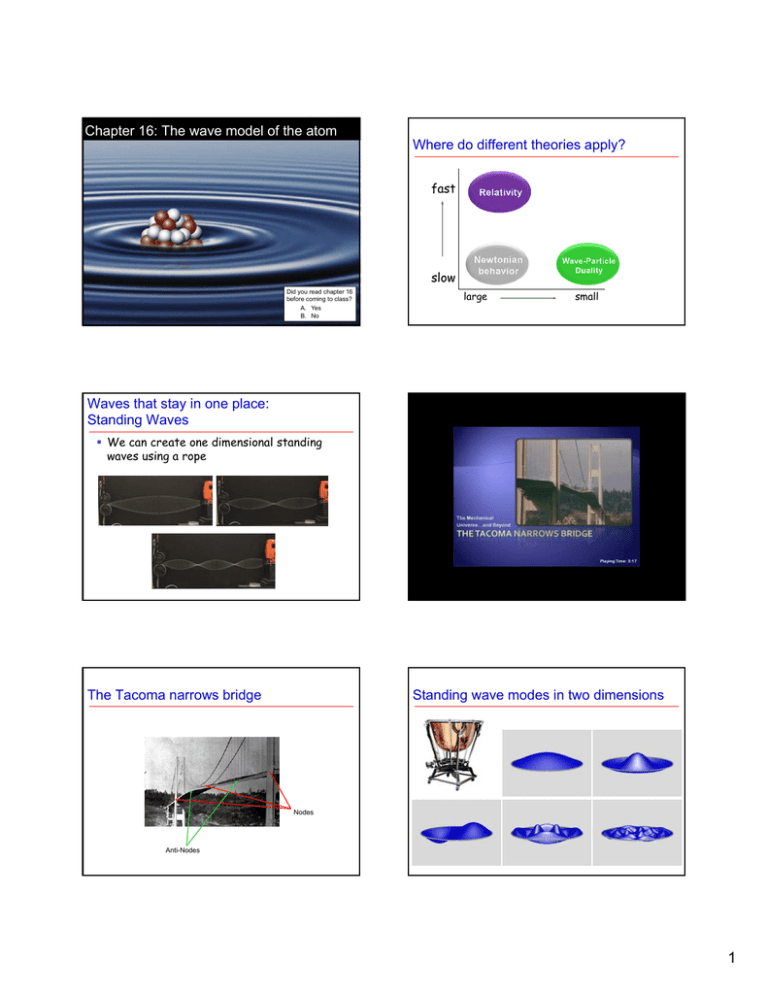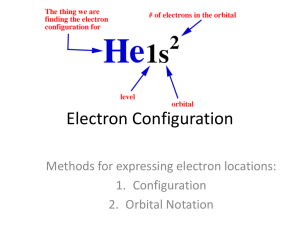Chapter 16: The wave model of the atom Standing Waves
advertisement

Chapter 16: The wave model of the atom Where do different theories apply? fast slow Did you read chapter 16 before coming to class? A. Yes B. No large small Waves that stay in one place: Standing Waves We can create one dimensional standing waves using a rope The Tacoma narrows bridge Standing wave modes in two dimensions Nodes Anti-Nodes 1 Standing wave modes in two dimensions Higher Dimensions Standing waves are possible in higher dimension, and can have complicated shapes. Different standing wave shapes are called “Modes”. In three dimensions you can also get standing waves • Singing in the shower • Stars vibrating Standing wave summary Standing waves form when a wave is confined They are naturally “quantized” in frequency They can have complex 1, 2, or 3 dimensional structure depending on how they are confined Standing surface wave pattern in a cup. The waves confined by gravity and the edges of the cup. The uncertainty principal states that a) b) c) d) What is the current understanding of what “waves” when a particle acts like a wave? a) The particle’s mass is extended through space and waves b) The probability of finding a particle in a given place is spread out and waves c) There is aluminiferous ether spread throughout space that waves Since each wavelength represents a different momentum, an unconfined traveling wave packet tends to spread out. We can’t know exactly where a particle is We can’t know exactly what a particles velocity is We can’t know exactly where a particle is and what is velocity is at the same time Scientists are kind of unsure about what they are doing 2 The Wave Model of the Atom Orbitals are three dimensional standing probability waves (found by solving the Shrödinger Wave equation ) The wave-particle duality of the electron requires us to treat electrons as waves as long as we aren’t “looking” at them. A 3-D electron standing probability wave surrounds the nucleus. • We think of the wave amplitude as representing the probability of measuring an electron to be located at each point in space. Because of the wave nature of electrons, we cannot know how they move around atoms. 1s orbital • An electrons in an atom has a very well-defined positions (i.e. atoms are small), so we can’t know about its velocity (momentum). We thus call these standing-wave probability distributions orbitals to reflect the idea that we cannot trace their movement like we can in an orbit (where a particle travels along a specific path). Visualizing orbitals can be tricky because they are 3-d entities with structure inside. We often just draw an outer “surface” that represents the general shape. An f orbital d orbitals Orbital Patterns The orbital types are labeled on as s, p, d, f, g, h, i, j, etc. Each new orbital type has two more orbitals than the previous one. Each orbital represents a standing wave pattern that an electron probability wave could take on. Orbital Type s p Orbitals of type 1 3 Electron Capacity 2 6 d f g h i j 5 7 9 11 13 15 10 14 18 22 26 30 http://winter.group.shef.ac.uk/orbitron/AOs/1s/index.html Orbitals come in “shells” The first shell contains only an s-orbital The second shell contains an s-orbital and 3 porbitals The third shell contains an s-orbital, 3 p-orbitals, and 5 d-orbitals Etc. More on shells Higher numbered shells are farther from the nucleus. • Electrons in higher shells therefore have more potential energy. The orbitals in higher numbered shells have more nodes. 3 Spin The Pauli Exclusion Principle Electrons (and other particles) have a property called “spin”, just as they have a property called “charge”. Spin describes the magnetic properties of the electron • An electron is sort of like a tiny magnet with a north and south pole. When we measure spin, we can only get one of two values: • Spin up (the electron’s magnet was aligned with our measurement) • Spin down (the electron’s magnet was aligned opposite our measurement) Although we call this spin, it does not describe mechanical spinning of the electron. (As best we can measure, the electron has no physical extent) No more than two electrons can occupy the same orbital (in a given shell). If two electrons are in the same orbital, they must have different spins. Understanding Atoms Electron energies - analogy The underground parking garage How do electrons fill the orbitals as we move along the periodic table? • Electrons fill the lowest energy levels first. d Level 3 p Level 2 p s Low energy 3 2 1 s Level 1 High energy s Hydrogen Helium free electron free electron Level 3 3d 3p 3s Level 3 3d 3p 3s Level 2 2p 2s Level 2 2p 2s Level 1 1s Level 1 1s 4 Lithium Beryllium free electron free electron Level 3 3d 3p 3s Level 3 3d 3p 3s Level 2 2p 2s Level 2 2p 2s Level 1 1s Level 1 1s Review How many p electrons can there be in a shell? Which orbitals are in third shell? How many electrons are in an atom that has both the first and second shells filled? 5



![6) cobalt [Ar] 4s 2 3d 7](http://s2.studylib.net/store/data/009918562_1-1950b3428f2f6bf78209e86f923b4abf-300x300.png)

